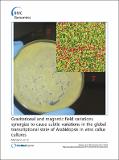Por favor, use este identificador para citar o enlazar a este item:
http://hdl.handle.net/10261/51004COMPARTIR / EXPORTAR:
 SHARE SHARE
 CORE
BASE CORE
BASE
|
|
| Visualizar otros formatos: MARC | Dublin Core | RDF | ORE | MODS | METS | DIDL | DATACITE | |

| Título: | Gravitational and magnetic field variations synergize to cause subtle variations in the global transcriptional state of Arabidopsis in vitro callus cultures |
Autor: | Manzano, Ana I. CSIC; van Loon, Jack JWA; Christianen, Peter C.M.; González-Rubio, Juana M. CSIC; Medina, F. Javier CSIC ORCID CVN ; Herranz, Raúl CSIC ORCID CVN | Fecha de publicación: | 21-mar-2012 | Editor: | BioMed Central | Citación: | BMC Genomics 13(1):105(2012) | Resumen: | Abstract Background Biological systems respond to changes in both the Earth's magnetic and gravitational fields, but as experiments in space are expensive and infrequent, Earth-based simulation techniques are required. A high gradient magnetic field can be used to levitate biological material, thereby simulating microgravity and can also create environments with a reduced or an enhanced level of gravity (g), although special attention should be paid to the possible effects of the magnetic field (B) itself. Results Using diamagnetic levitation, we exposed Arabidopsis thaliana in vitro callus cultures to five environments with different levels of effective gravity and magnetic field strengths. The environments included levitation, i.e. simulated μg* (close to 0 g* at B = 10.1 T), intermediate g* (0.1 g* at B = 14.7 T) and enhanced gravity levels (1.9 g* at B = 14.7 T and 2 g* at B = 10.1 T) plus an internal 1 g* control (B = 16.5 T). The asterisk denotes the presence of the background magnetic field, as opposed to the effective gravity environments in the absence of an applied magnetic field, created using a Random Position Machine (simulated μg) and a Large Diameter Centrifuge (2 g). Microarray analysis indicates that changes in the overall gene expression of cultured cells exposed to these unusual environments barely reach significance using an FDR algorithm. However, it was found that gravitational and magnetic fields produce synergistic variations in the steady state of the transcriptional profile of plants. Transcriptomic results confirm that high gradient magnetic fields (i.e. to create μg* and 2 g* conditions) have a significant effect, mainly on structural, abiotic stress genes and secondary metabolism genes, but these subtle gravitational effects are only observable using clustering methodologies. Conclusions A detailed microarray dataset analysis, based on clustering of similarly expressed genes (GEDI software), can detect underlying global-scale responses, which cannot be detected by means of individual gene expression techniques using raw or corrected p values (FDR). A subtle, but consistent, genome-scale response to hypogravity environments was found, which was opposite to the response in a hypergravity environment. | Versión del editor: | http://dx.doi.org/10.1186/1471-2164-13-105 | URI: | http://hdl.handle.net/10261/51004 | DOI: | 10.1186/1471-2164-13-105 | ISSN: | 1471-2164 | E-ISSN: | 1471-2164 |
| Aparece en las colecciones: | (CIB) Artículos (CNB) Artículos |
Ficheros en este ítem:
| Fichero | Descripción | Tamaño | Formato | |
|---|---|---|---|---|
| 1471-2164-13-105.xml | 78,73 kB | XML | Visualizar/Abrir | |
| 1471-2164-13-105-S1.PDF | 541,16 kB | Adobe PDF |  Visualizar/Abrir | |
| 1471-2164-13-105-S3.XLS | 259 kB | Microsoft Excel | Visualizar/Abrir | |
| 1471-2164-13-105.pdf | 1,69 MB | Adobe PDF |  Visualizar/Abrir | |
| 1471-2164-13-105-S4.ZIP | 13,67 MB | Unknown | Visualizar/Abrir | |
| 1471-2164-13-105-S2.XLS | 3,03 MB | Microsoft Excel | Visualizar/Abrir |
CORE Recommender
PubMed Central
Citations
17
checked on 10-abr-2024
SCOPUSTM
Citations
40
checked on 18-abr-2024
WEB OF SCIENCETM
Citations
41
checked on 29-feb-2024
Page view(s)
357
checked on 23-abr-2024
Download(s)
671
checked on 23-abr-2024
Google ScholarTM
Check
Altmetric
Altmetric
Artículos relacionados:
NOTA: Los ítems de Digital.CSIC están protegidos por copyright, con todos los derechos reservados, a menos que se indique lo contrario.
